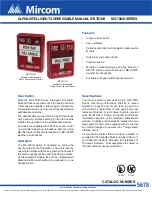Technical/Programming Manual
FT1020G3 Rev 2.2.1
107
Figure 38 explanation:
In this example, the week average sensor value and the decision value are "10" (=1%/m)
at the "starting point", i.e. due to contamination the smouldering level has been adjusted to
"24" (10+14), the pre-warning level to "32" (10+22) and the fire alarm level to "40" (10+30).
When a smouldering fire starts, the sensor values and the decision values will increase
slowly from "10" and upwards.
1. The decision value has reached the smouldering level. A 7 minutes timer is started.
2. After the 7 minutes, the decision value is still over the smouldering level and the
pre-warning level and the fire alarm level are lowered. A 90 minutes timer is
started.
3. The decision value has reached the pre-warning level and pre-warning is activated.
4. After the 90 minutes the decision value is still over the pre-warning level but has
not reached the fire alarm level. The pre-warning level and the fire alarm level are
lowered again. A 120 minutes timer is started.
5. The decision value has here reached the fire alarm level and fire alarm is activated.
6. The decision value has reached the original fire alarm level
“40”, i.e. the fire alarm
would have been activated approx. 90 minutes
after the fire alarm is activated
by
the smouldering algorithm!
17.4.4
Performance factor
To find out the environment conditions where an analogue smoke detector 430x/440x in
NORMAL mode is mounted, the
performance factor (PF)
can be studied. The
performance factor is shown in menu H4/U4 together with the minimum and maximum
sensor values. All three values should be studied together. Example, one or two high
sensor values will not result in a high performance factor. The performance factor is
calculated for each detector individually.
Each sensor value is compared with the week average sensor value. The absolute
difference is saved and each twenty-four hour (at midnight) is an "average value" is
calculated, i.e. the performance factor. (12343 = samples per 24 hours)
Where,
X
m
= momentary sensor values for 24 hours.
X
wa
= week average sensor value
If the detector is mounted in a very "stable" environment, the
performance factor will be low (min. 0 %/m).
If the detector is mounted in a very "unstable" environment, the performance factor will be
high (max. 2.55 %/m).
An "unstable" environment can cause nuisance alarms (unnecessary alarms). Perhaps
should another type of detector or alarm algorithm be used or other functions, e.g. alert
annunciation or two-address dependence.
17.5
Algorithms for Analogue heat detectors
The heat detectors conform to a class according to the requirements of the tests specified
in AS7240.5.
Each Analogue heat detector can have two alarm algorithms programmed (via EBLWin).
One
Regular alarm algorithm
that is normally used and one
Alternative alarm algorithm
that is turned on/off via a time channel (internal or external) e.g. class A1 can be used
during night-time and class B can be used during daytime (the alternative alarm algorithm
Содержание Firetracker FT1020G3 CIE
Страница 1: ...Technical Programming Manual FT1020G3 Rev 2 2 1 For Software V2 2 x FT1020G3 CIE M435 February 2016 ...
Страница 2: ...This page has deliberately been left blank ...
Страница 187: ...Technical Programming Manual FT1020G3 Rev 2 2 1 184 Figure 60 FT1020G3 General arrangement ...
Страница 188: ...Technical Programming Manual FT1020G3 Rev 2 2 1 185 Figure 61 FT1020G3 Block Wiring Overview ...
Страница 189: ...Technical Programming Manual FT1020G3 Rev 2 2 1 186 Figure 62 FT1020G3 Standard Block Wiring Diagram ...











